Critical Evaluation of Digital Drilling in Offshore Oil and Gas
VerifiedAdded on 2019/10/31
|56
|13985
|134
Thesis and Dissertation
AI Summary
This dissertation critically evaluates the impact of digital drilling on minimizing inefficiencies in offshore drilling activities within the oil and gas industry. The research examines the benefits of digital drilling, including cost reduction, improved efficiency, and automation. The study employs a qualitative research approach, including thematic analysis of secondary data. The analysis explores advantages of digital drilling, challenges of digitalization, industry scope, company statistics, and trends. The study aims to determine if digital drilling can help manage costs, enhance safety, optimize performance, and resolve production issues. The research also provides recommendations for future studies and highlights limitations. The dissertation's findings are linked to the study objectives and offers a comprehensive understanding of digital drilling's impact on the oil and gas industry.
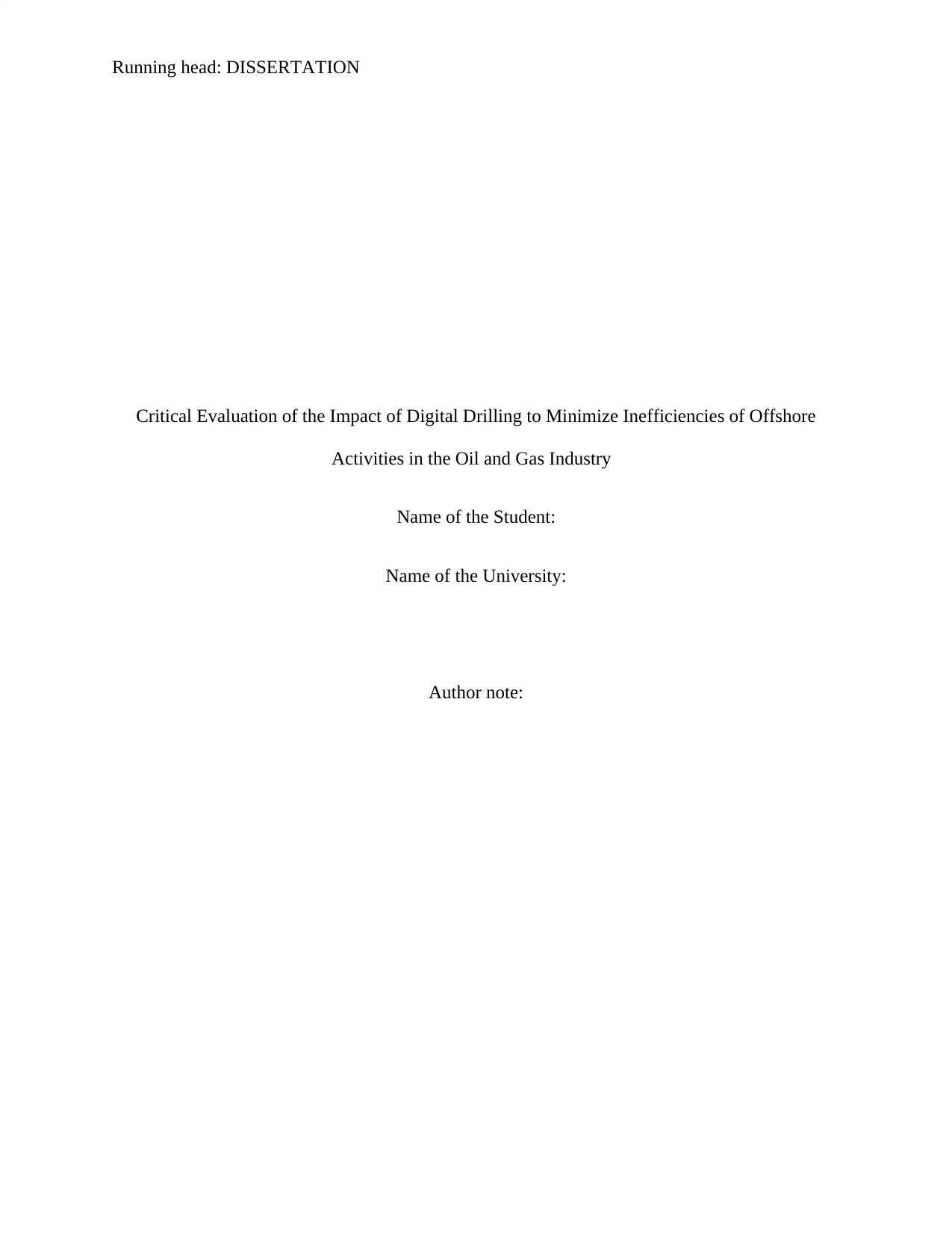
Running head: DISSERTATION
Critical Evaluation of the Impact of Digital Drilling to Minimize Inefficiencies of Offshore
Activities in the Oil and Gas Industry
Name of the Student:
Name of the University:
Author note:
Critical Evaluation of the Impact of Digital Drilling to Minimize Inefficiencies of Offshore
Activities in the Oil and Gas Industry
Name of the Student:
Name of the University:
Author note:
Paraphrase This Document
Need a fresh take? Get an instant paraphrase of this document with our AI Paraphraser
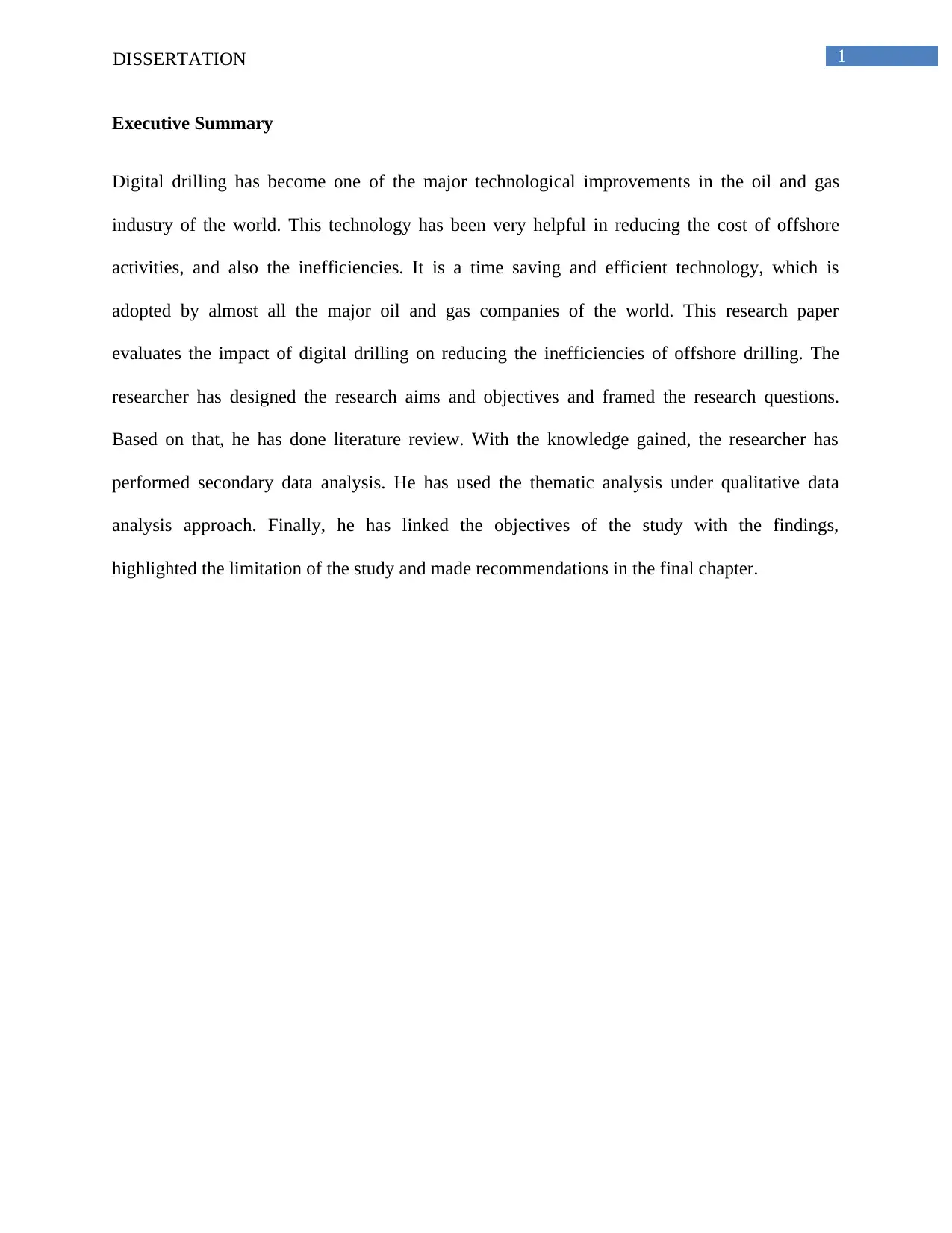
1DISSERTATION
Executive Summary
Digital drilling has become one of the major technological improvements in the oil and gas
industry of the world. This technology has been very helpful in reducing the cost of offshore
activities, and also the inefficiencies. It is a time saving and efficient technology, which is
adopted by almost all the major oil and gas companies of the world. This research paper
evaluates the impact of digital drilling on reducing the inefficiencies of offshore drilling. The
researcher has designed the research aims and objectives and framed the research questions.
Based on that, he has done literature review. With the knowledge gained, the researcher has
performed secondary data analysis. He has used the thematic analysis under qualitative data
analysis approach. Finally, he has linked the objectives of the study with the findings,
highlighted the limitation of the study and made recommendations in the final chapter.
Executive Summary
Digital drilling has become one of the major technological improvements in the oil and gas
industry of the world. This technology has been very helpful in reducing the cost of offshore
activities, and also the inefficiencies. It is a time saving and efficient technology, which is
adopted by almost all the major oil and gas companies of the world. This research paper
evaluates the impact of digital drilling on reducing the inefficiencies of offshore drilling. The
researcher has designed the research aims and objectives and framed the research questions.
Based on that, he has done literature review. With the knowledge gained, the researcher has
performed secondary data analysis. He has used the thematic analysis under qualitative data
analysis approach. Finally, he has linked the objectives of the study with the findings,
highlighted the limitation of the study and made recommendations in the final chapter.
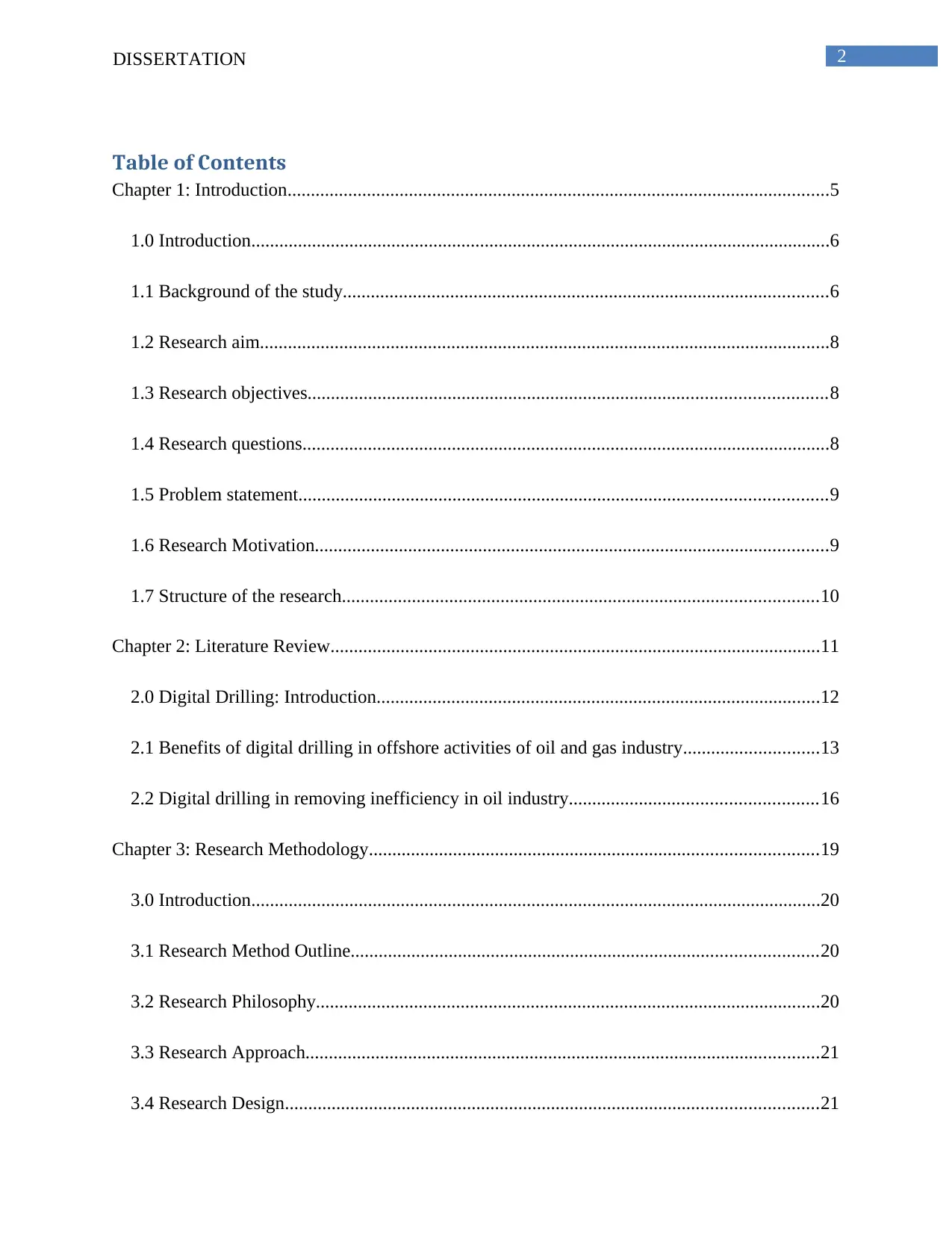
2DISSERTATION
Table of Contents
Chapter 1: Introduction....................................................................................................................5
1.0 Introduction............................................................................................................................6
1.1 Background of the study........................................................................................................6
1.2 Research aim..........................................................................................................................8
1.3 Research objectives...............................................................................................................8
1.4 Research questions.................................................................................................................8
1.5 Problem statement.................................................................................................................9
1.6 Research Motivation..............................................................................................................9
1.7 Structure of the research......................................................................................................10
Chapter 2: Literature Review.........................................................................................................11
2.0 Digital Drilling: Introduction...............................................................................................12
2.1 Benefits of digital drilling in offshore activities of oil and gas industry.............................13
2.2 Digital drilling in removing inefficiency in oil industry.....................................................16
Chapter 3: Research Methodology................................................................................................19
3.0 Introduction..........................................................................................................................20
3.1 Research Method Outline....................................................................................................20
3.2 Research Philosophy............................................................................................................20
3.3 Research Approach..............................................................................................................21
3.4 Research Design..................................................................................................................21
Table of Contents
Chapter 1: Introduction....................................................................................................................5
1.0 Introduction............................................................................................................................6
1.1 Background of the study........................................................................................................6
1.2 Research aim..........................................................................................................................8
1.3 Research objectives...............................................................................................................8
1.4 Research questions.................................................................................................................8
1.5 Problem statement.................................................................................................................9
1.6 Research Motivation..............................................................................................................9
1.7 Structure of the research......................................................................................................10
Chapter 2: Literature Review.........................................................................................................11
2.0 Digital Drilling: Introduction...............................................................................................12
2.1 Benefits of digital drilling in offshore activities of oil and gas industry.............................13
2.2 Digital drilling in removing inefficiency in oil industry.....................................................16
Chapter 3: Research Methodology................................................................................................19
3.0 Introduction..........................................................................................................................20
3.1 Research Method Outline....................................................................................................20
3.2 Research Philosophy............................................................................................................20
3.3 Research Approach..............................................................................................................21
3.4 Research Design..................................................................................................................21
⊘ This is a preview!⊘
Do you want full access?
Subscribe today to unlock all pages.

Trusted by 1+ million students worldwide
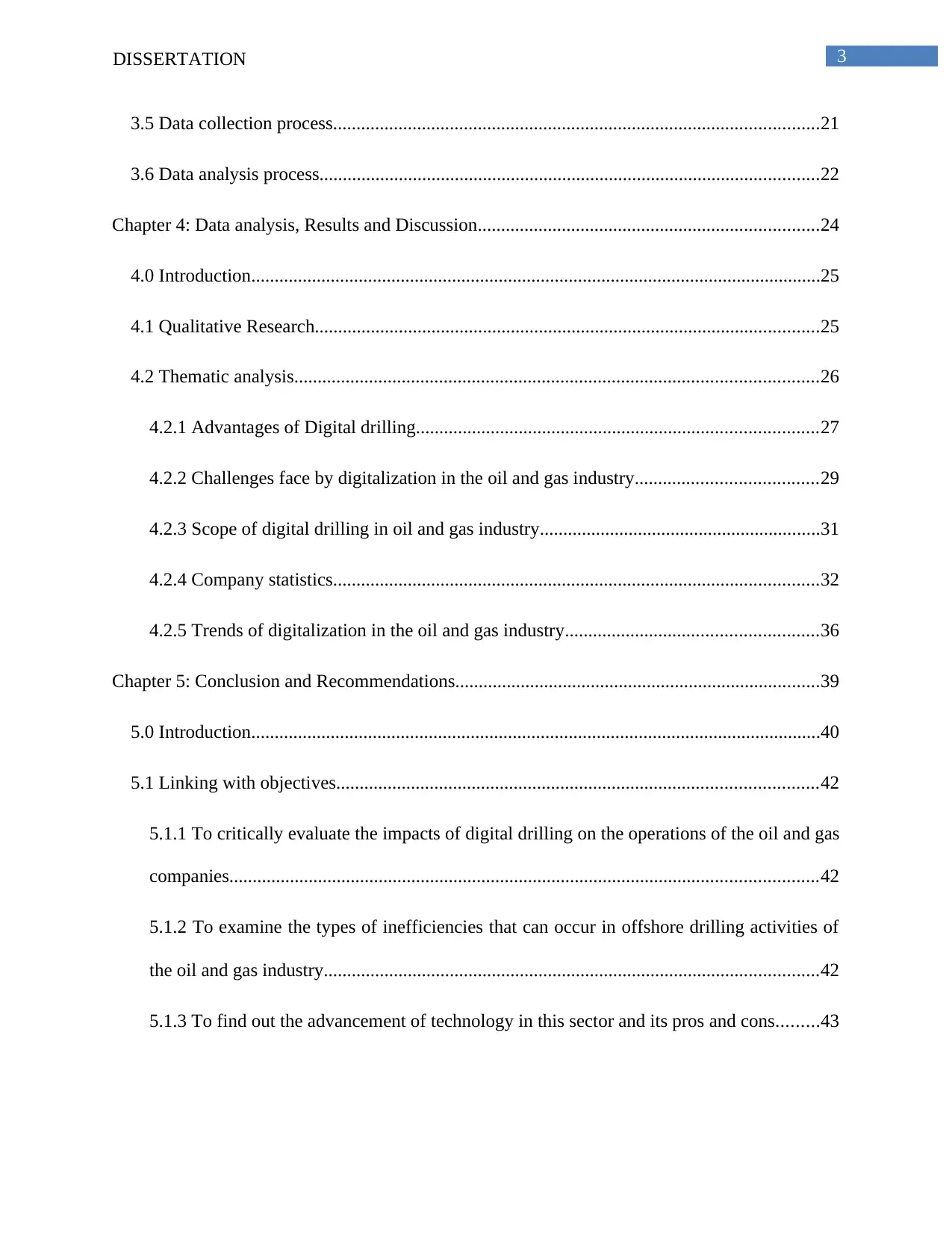
3DISSERTATION
3.5 Data collection process........................................................................................................21
3.6 Data analysis process...........................................................................................................22
Chapter 4: Data analysis, Results and Discussion.........................................................................24
4.0 Introduction..........................................................................................................................25
4.1 Qualitative Research............................................................................................................25
4.2 Thematic analysis................................................................................................................26
4.2.1 Advantages of Digital drilling......................................................................................27
4.2.2 Challenges face by digitalization in the oil and gas industry.......................................29
4.2.3 Scope of digital drilling in oil and gas industry............................................................31
4.2.4 Company statistics........................................................................................................32
4.2.5 Trends of digitalization in the oil and gas industry......................................................36
Chapter 5: Conclusion and Recommendations..............................................................................39
5.0 Introduction..........................................................................................................................40
5.1 Linking with objectives.......................................................................................................42
5.1.1 To critically evaluate the impacts of digital drilling on the operations of the oil and gas
companies..............................................................................................................................42
5.1.2 To examine the types of inefficiencies that can occur in offshore drilling activities of
the oil and gas industry..........................................................................................................42
5.1.3 To find out the advancement of technology in this sector and its pros and cons.........43
3.5 Data collection process........................................................................................................21
3.6 Data analysis process...........................................................................................................22
Chapter 4: Data analysis, Results and Discussion.........................................................................24
4.0 Introduction..........................................................................................................................25
4.1 Qualitative Research............................................................................................................25
4.2 Thematic analysis................................................................................................................26
4.2.1 Advantages of Digital drilling......................................................................................27
4.2.2 Challenges face by digitalization in the oil and gas industry.......................................29
4.2.3 Scope of digital drilling in oil and gas industry............................................................31
4.2.4 Company statistics........................................................................................................32
4.2.5 Trends of digitalization in the oil and gas industry......................................................36
Chapter 5: Conclusion and Recommendations..............................................................................39
5.0 Introduction..........................................................................................................................40
5.1 Linking with objectives.......................................................................................................42
5.1.1 To critically evaluate the impacts of digital drilling on the operations of the oil and gas
companies..............................................................................................................................42
5.1.2 To examine the types of inefficiencies that can occur in offshore drilling activities of
the oil and gas industry..........................................................................................................42
5.1.3 To find out the advancement of technology in this sector and its pros and cons.........43
Paraphrase This Document
Need a fresh take? Get an instant paraphrase of this document with our AI Paraphraser

4DISSERTATION
5.1.4 To find out the implementation of digital drilling on the offshore drilling operations of
the oil and gas companies......................................................................................................43
5.2 Recommendations................................................................................................................44
5.3 Research Limitations...........................................................................................................45
5.4 Future Scope of the Study....................................................................................................46
References.....................................................................................................................................47
5.1.4 To find out the implementation of digital drilling on the offshore drilling operations of
the oil and gas companies......................................................................................................43
5.2 Recommendations................................................................................................................44
5.3 Research Limitations...........................................................................................................45
5.4 Future Scope of the Study....................................................................................................46
References.....................................................................................................................................47

5DISSERTATION
Chapter 1: Introduction
Chapter 1: Introduction
⊘ This is a preview!⊘
Do you want full access?
Subscribe today to unlock all pages.

Trusted by 1+ million students worldwide

6DISSERTATION
1.0 Introduction
The purpose of the following research paper is to critically evaluate the impacts of digital
drilling in minimizing the inefficiencies of offshore drilling activities in the oil and gas industry.
The oil and gas industry is one of the major industries of the world. It explores the oil and gas
resources and supplies the energy to the world. The resources are located majorly in the Middle
East. 80% of the oil reserves are mainly controlled by the national oil companies (Kelland 2014).
The developed countries are the major consumers of the oil and gas reserves. To control the
reserves and unify the oil polices, OPEC, that is, Organization of the Petroleum Exporting
Countries was founded in Baghdad, Iran in 1960 and the headquarters was set up in Vienna,
Austria in 1965. Since then, all the major decisions regarding oil and gas activities are designed
and controlled by OPEC (Finšgar and Jackson 2014). The oil and gas industry is comprised of
many big companies across the world and among them, the major companies are, Big Oil, Saudi
Aramco, NIOC, Qatar Petroleum, ExxonMobil, BP, Shell, Petro China etc. The oil and gas
industry of the world faces any problems, including, political risk, geological risk, price risk,
supply and demand risks, and cost risks. This industry also faces technological issues. The
activities are classified into onshore and offshore activities. The digital drilling is a type of
technology used in offshore activities (Yusufet al. 2014). The research paper focuses on the
inefficiencies of the offshore activities and how the digital drilling helps to minimize the
inefficiencies in the oil and gas industry.
1.0 Introduction
The purpose of the following research paper is to critically evaluate the impacts of digital
drilling in minimizing the inefficiencies of offshore drilling activities in the oil and gas industry.
The oil and gas industry is one of the major industries of the world. It explores the oil and gas
resources and supplies the energy to the world. The resources are located majorly in the Middle
East. 80% of the oil reserves are mainly controlled by the national oil companies (Kelland 2014).
The developed countries are the major consumers of the oil and gas reserves. To control the
reserves and unify the oil polices, OPEC, that is, Organization of the Petroleum Exporting
Countries was founded in Baghdad, Iran in 1960 and the headquarters was set up in Vienna,
Austria in 1965. Since then, all the major decisions regarding oil and gas activities are designed
and controlled by OPEC (Finšgar and Jackson 2014). The oil and gas industry is comprised of
many big companies across the world and among them, the major companies are, Big Oil, Saudi
Aramco, NIOC, Qatar Petroleum, ExxonMobil, BP, Shell, Petro China etc. The oil and gas
industry of the world faces any problems, including, political risk, geological risk, price risk,
supply and demand risks, and cost risks. This industry also faces technological issues. The
activities are classified into onshore and offshore activities. The digital drilling is a type of
technology used in offshore activities (Yusufet al. 2014). The research paper focuses on the
inefficiencies of the offshore activities and how the digital drilling helps to minimize the
inefficiencies in the oil and gas industry.
Paraphrase This Document
Need a fresh take? Get an instant paraphrase of this document with our AI Paraphraser
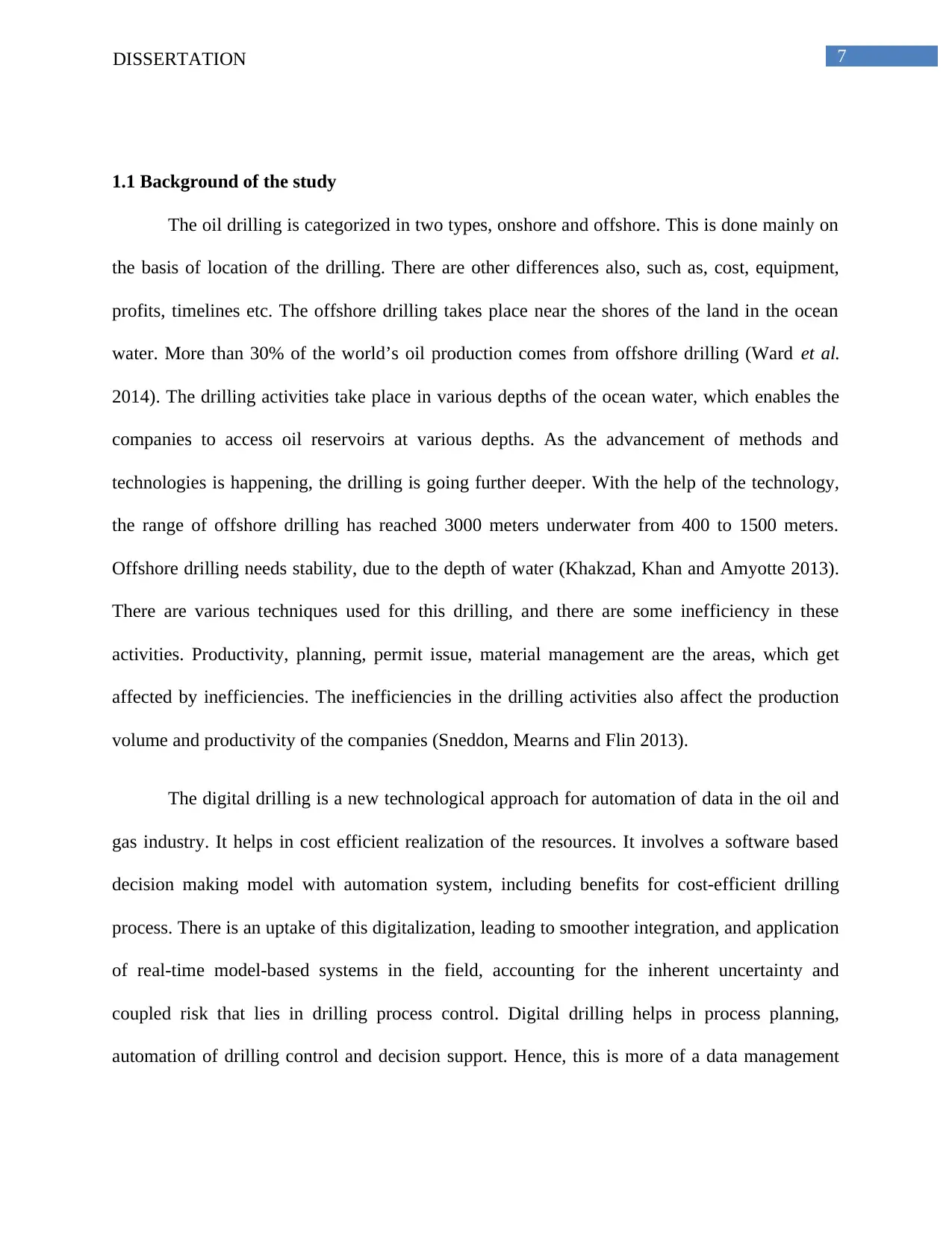
7DISSERTATION
1.1 Background of the study
The oil drilling is categorized in two types, onshore and offshore. This is done mainly on
the basis of location of the drilling. There are other differences also, such as, cost, equipment,
profits, timelines etc. The offshore drilling takes place near the shores of the land in the ocean
water. More than 30% of the world’s oil production comes from offshore drilling (Ward et al.
2014). The drilling activities take place in various depths of the ocean water, which enables the
companies to access oil reservoirs at various depths. As the advancement of methods and
technologies is happening, the drilling is going further deeper. With the help of the technology,
the range of offshore drilling has reached 3000 meters underwater from 400 to 1500 meters.
Offshore drilling needs stability, due to the depth of water (Khakzad, Khan and Amyotte 2013).
There are various techniques used for this drilling, and there are some inefficiency in these
activities. Productivity, planning, permit issue, material management are the areas, which get
affected by inefficiencies. The inefficiencies in the drilling activities also affect the production
volume and productivity of the companies (Sneddon, Mearns and Flin 2013).
The digital drilling is a new technological approach for automation of data in the oil and
gas industry. It helps in cost efficient realization of the resources. It involves a software based
decision making model with automation system, including benefits for cost-efficient drilling
process. There is an uptake of this digitalization, leading to smoother integration, and application
of real-time model-based systems in the field, accounting for the inherent uncertainty and
coupled risk that lies in drilling process control. Digital drilling helps in process planning,
automation of drilling control and decision support. Hence, this is more of a data management
1.1 Background of the study
The oil drilling is categorized in two types, onshore and offshore. This is done mainly on
the basis of location of the drilling. There are other differences also, such as, cost, equipment,
profits, timelines etc. The offshore drilling takes place near the shores of the land in the ocean
water. More than 30% of the world’s oil production comes from offshore drilling (Ward et al.
2014). The drilling activities take place in various depths of the ocean water, which enables the
companies to access oil reservoirs at various depths. As the advancement of methods and
technologies is happening, the drilling is going further deeper. With the help of the technology,
the range of offshore drilling has reached 3000 meters underwater from 400 to 1500 meters.
Offshore drilling needs stability, due to the depth of water (Khakzad, Khan and Amyotte 2013).
There are various techniques used for this drilling, and there are some inefficiency in these
activities. Productivity, planning, permit issue, material management are the areas, which get
affected by inefficiencies. The inefficiencies in the drilling activities also affect the production
volume and productivity of the companies (Sneddon, Mearns and Flin 2013).
The digital drilling is a new technological approach for automation of data in the oil and
gas industry. It helps in cost efficient realization of the resources. It involves a software based
decision making model with automation system, including benefits for cost-efficient drilling
process. There is an uptake of this digitalization, leading to smoother integration, and application
of real-time model-based systems in the field, accounting for the inherent uncertainty and
coupled risk that lies in drilling process control. Digital drilling helps in process planning,
automation of drilling control and decision support. Hence, this is more of a data management

8DISSERTATION
system in the oil and gas industry to manage the operation process smoothly and cost efficiently
(Abimbola, Khan and Khakzad 2014).
As the technology is progressing rapidly, the operations of the oil and gas companies are
changing rapidly. The drilling is going deeper due to increasing demand, at the same time
inefficiencies and issues are increasing too (Jones, Sugiura and Downhole 2017). It should be
assessed that if there is any relation between the digital drilling and efficiency of offshore
activities.
1.2 Research aim
The aim of this research study is to critically evaluate the impact of the digital drilling on
the offshore activities of the oil and gas industries and if that helps in minimizing the
inefficiencies in the offshore activities. The researcher would review previous literatures on the
oil and gas industry to gather knowledge on the oil industry in details and about the digital
drilling. The researcher also would like to know more about the advantages and disadvantages of
digital drilling. The impact of this type of drilling can be understood from the performance of the
companies, who use it and from the production level. Hence, it is essential to critically analyze
the impacts of digital drilling to know if the inefficiencies of the companies.
1.3 Research objectives
The objectives of the research paper are:
To identify various challenges encountered by oil and gas companies facing increasing
cost of production in a low oil priced environment,
Identify technological solutions to resolve the problems of escalating production costs,
system in the oil and gas industry to manage the operation process smoothly and cost efficiently
(Abimbola, Khan and Khakzad 2014).
As the technology is progressing rapidly, the operations of the oil and gas companies are
changing rapidly. The drilling is going deeper due to increasing demand, at the same time
inefficiencies and issues are increasing too (Jones, Sugiura and Downhole 2017). It should be
assessed that if there is any relation between the digital drilling and efficiency of offshore
activities.
1.2 Research aim
The aim of this research study is to critically evaluate the impact of the digital drilling on
the offshore activities of the oil and gas industries and if that helps in minimizing the
inefficiencies in the offshore activities. The researcher would review previous literatures on the
oil and gas industry to gather knowledge on the oil industry in details and about the digital
drilling. The researcher also would like to know more about the advantages and disadvantages of
digital drilling. The impact of this type of drilling can be understood from the performance of the
companies, who use it and from the production level. Hence, it is essential to critically analyze
the impacts of digital drilling to know if the inefficiencies of the companies.
1.3 Research objectives
The objectives of the research paper are:
To identify various challenges encountered by oil and gas companies facing increasing
cost of production in a low oil priced environment,
Identify technological solutions to resolve the problems of escalating production costs,
⊘ This is a preview!⊘
Do you want full access?
Subscribe today to unlock all pages.

Trusted by 1+ million students worldwide
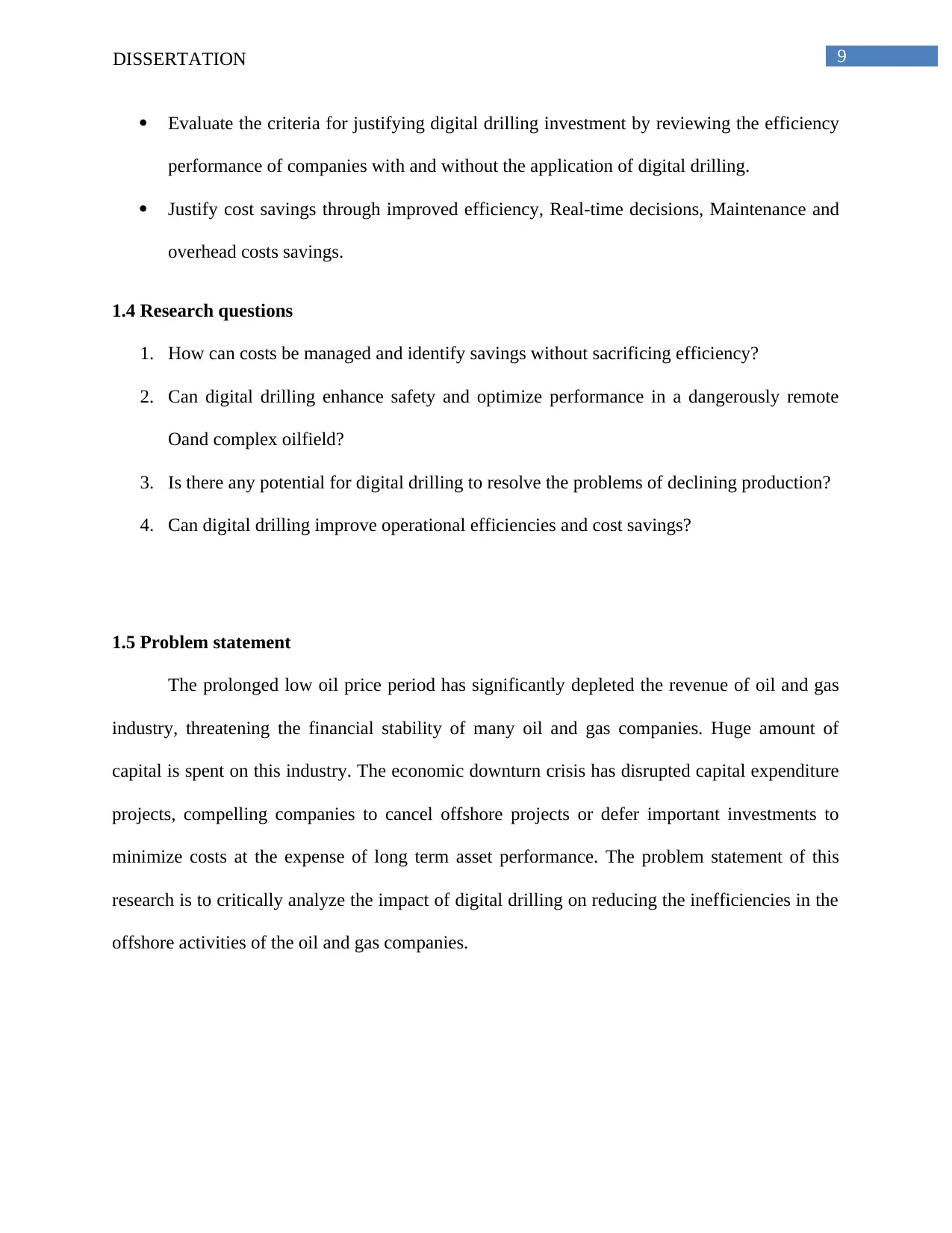
9DISSERTATION
Evaluate the criteria for justifying digital drilling investment by reviewing the efficiency
performance of companies with and without the application of digital drilling.
Justify cost savings through improved efficiency, Real-time decisions, Maintenance and
overhead costs savings.
1.4 Research questions
1. How can costs be managed and identify savings without sacrificing efficiency?
2. Can digital drilling enhance safety and optimize performance in a dangerously remote
Oand complex oilfield?
3. Is there any potential for digital drilling to resolve the problems of declining production?
4. Can digital drilling improve operational efficiencies and cost savings?
1.5 Problem statement
The prolonged low oil price period has significantly depleted the revenue of oil and gas
industry, threatening the financial stability of many oil and gas companies. Huge amount of
capital is spent on this industry. The economic downturn crisis has disrupted capital expenditure
projects, compelling companies to cancel offshore projects or defer important investments to
minimize costs at the expense of long term asset performance. The problem statement of this
research is to critically analyze the impact of digital drilling on reducing the inefficiencies in the
offshore activities of the oil and gas companies.
Evaluate the criteria for justifying digital drilling investment by reviewing the efficiency
performance of companies with and without the application of digital drilling.
Justify cost savings through improved efficiency, Real-time decisions, Maintenance and
overhead costs savings.
1.4 Research questions
1. How can costs be managed and identify savings without sacrificing efficiency?
2. Can digital drilling enhance safety and optimize performance in a dangerously remote
Oand complex oilfield?
3. Is there any potential for digital drilling to resolve the problems of declining production?
4. Can digital drilling improve operational efficiencies and cost savings?
1.5 Problem statement
The prolonged low oil price period has significantly depleted the revenue of oil and gas
industry, threatening the financial stability of many oil and gas companies. Huge amount of
capital is spent on this industry. The economic downturn crisis has disrupted capital expenditure
projects, compelling companies to cancel offshore projects or defer important investments to
minimize costs at the expense of long term asset performance. The problem statement of this
research is to critically analyze the impact of digital drilling on reducing the inefficiencies in the
offshore activities of the oil and gas companies.
Paraphrase This Document
Need a fresh take? Get an instant paraphrase of this document with our AI Paraphraser
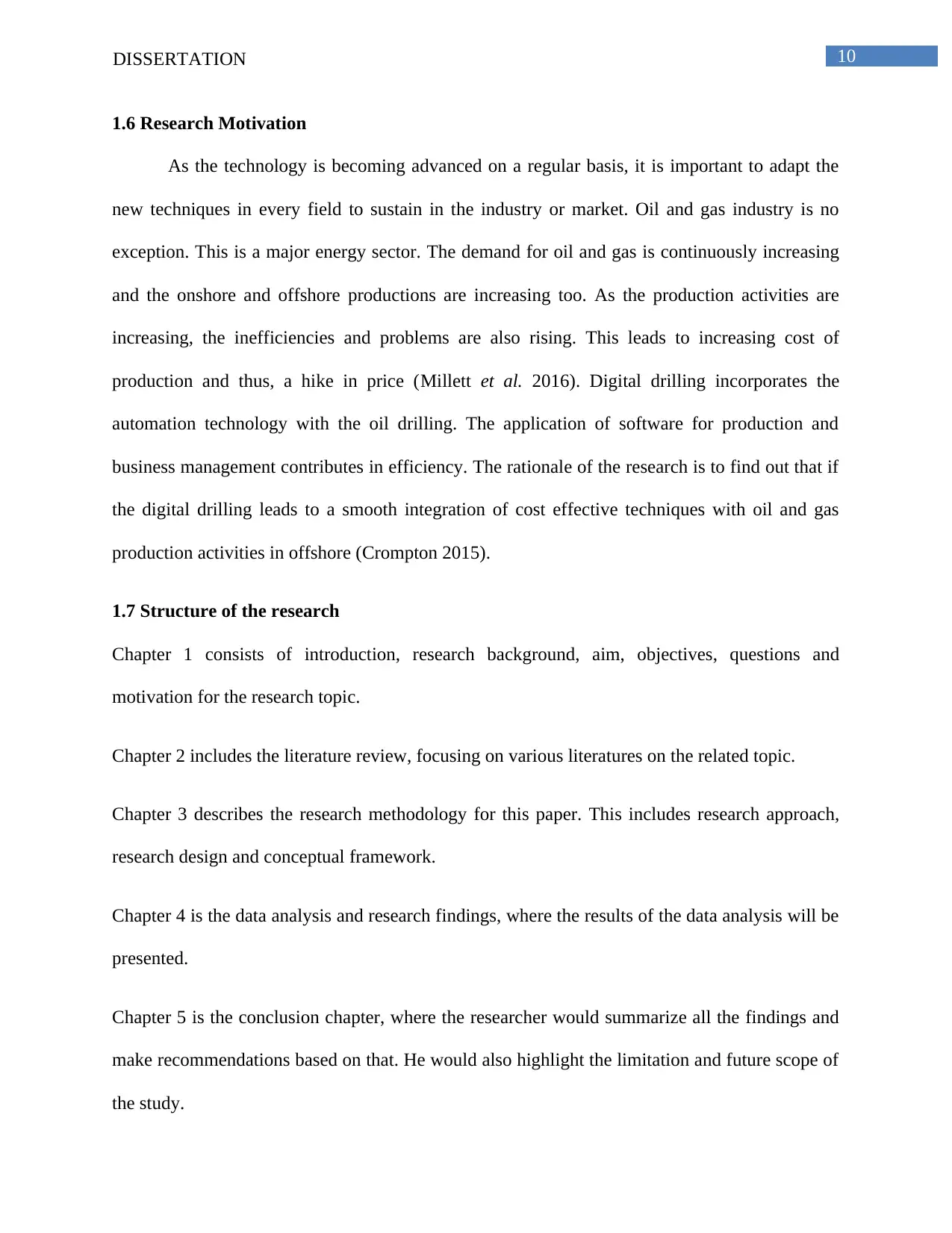
10DISSERTATION
1.6 Research Motivation
As the technology is becoming advanced on a regular basis, it is important to adapt the
new techniques in every field to sustain in the industry or market. Oil and gas industry is no
exception. This is a major energy sector. The demand for oil and gas is continuously increasing
and the onshore and offshore productions are increasing too. As the production activities are
increasing, the inefficiencies and problems are also rising. This leads to increasing cost of
production and thus, a hike in price (Millett et al. 2016). Digital drilling incorporates the
automation technology with the oil drilling. The application of software for production and
business management contributes in efficiency. The rationale of the research is to find out that if
the digital drilling leads to a smooth integration of cost effective techniques with oil and gas
production activities in offshore (Crompton 2015).
1.7 Structure of the research
Chapter 1 consists of introduction, research background, aim, objectives, questions and
motivation for the research topic.
Chapter 2 includes the literature review, focusing on various literatures on the related topic.
Chapter 3 describes the research methodology for this paper. This includes research approach,
research design and conceptual framework.
Chapter 4 is the data analysis and research findings, where the results of the data analysis will be
presented.
Chapter 5 is the conclusion chapter, where the researcher would summarize all the findings and
make recommendations based on that. He would also highlight the limitation and future scope of
the study.
1.6 Research Motivation
As the technology is becoming advanced on a regular basis, it is important to adapt the
new techniques in every field to sustain in the industry or market. Oil and gas industry is no
exception. This is a major energy sector. The demand for oil and gas is continuously increasing
and the onshore and offshore productions are increasing too. As the production activities are
increasing, the inefficiencies and problems are also rising. This leads to increasing cost of
production and thus, a hike in price (Millett et al. 2016). Digital drilling incorporates the
automation technology with the oil drilling. The application of software for production and
business management contributes in efficiency. The rationale of the research is to find out that if
the digital drilling leads to a smooth integration of cost effective techniques with oil and gas
production activities in offshore (Crompton 2015).
1.7 Structure of the research
Chapter 1 consists of introduction, research background, aim, objectives, questions and
motivation for the research topic.
Chapter 2 includes the literature review, focusing on various literatures on the related topic.
Chapter 3 describes the research methodology for this paper. This includes research approach,
research design and conceptual framework.
Chapter 4 is the data analysis and research findings, where the results of the data analysis will be
presented.
Chapter 5 is the conclusion chapter, where the researcher would summarize all the findings and
make recommendations based on that. He would also highlight the limitation and future scope of
the study.

11DISSERTATION
⊘ This is a preview!⊘
Do you want full access?
Subscribe today to unlock all pages.

Trusted by 1+ million students worldwide
1 out of 56
Related Documents
Your All-in-One AI-Powered Toolkit for Academic Success.
+13062052269
info@desklib.com
Available 24*7 on WhatsApp / Email
![[object Object]](/_next/static/media/star-bottom.7253800d.svg)
Unlock your academic potential
Copyright © 2020–2025 A2Z Services. All Rights Reserved. Developed and managed by ZUCOL.





